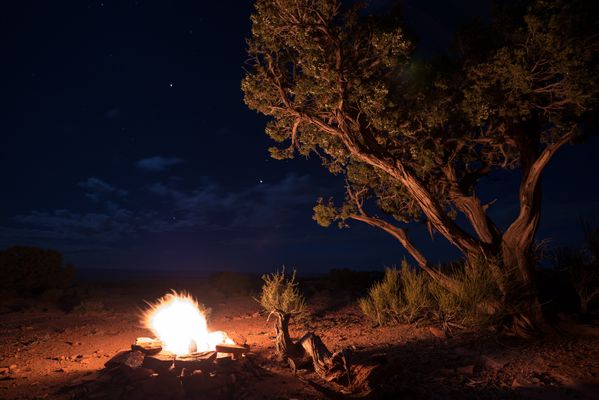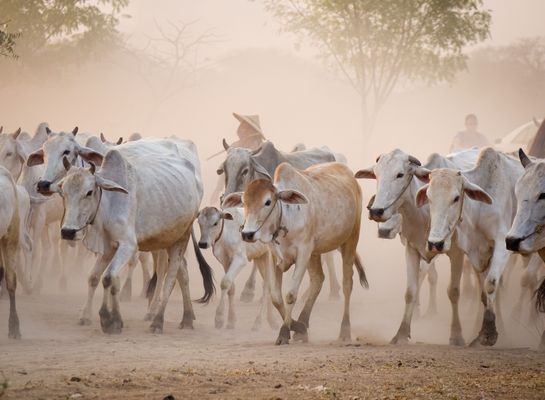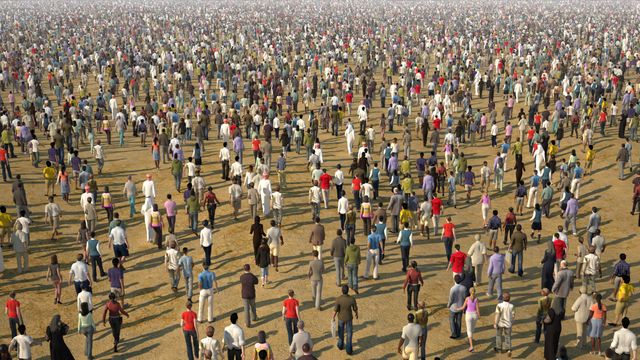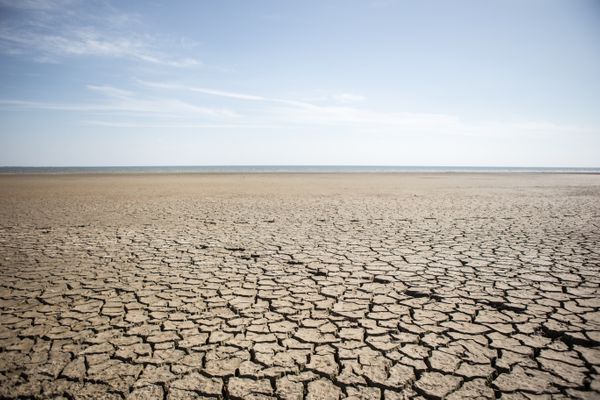17.1.11
Desertification in Africa
What are the Causes of Desertification?
What are the Causes of Desertification?
Desertification describes land getting drier, less fertile and more like a desert. After desertification, it is harder to grow crops and survive in the ecosystem. The main factors that lead to desertification are:


Removal of fuel wood
Removal of fuel wood
- Logging and cutting down trees to burn as fuel means that an area has fewer trees. This means that soil is not bound to tree roots and is more likely to be washed away.
- Removing fuel wood increases soil erosion.


Overgrazing
Overgrazing
- If livestock eat every plant on a plot of land, then this can again cause soil erosion.
- There will be no roots to bind the soil together and plants may struggle to grow again for a very long time.


Over-cultivation
Over-cultivation
- Fallow years are held because planting crops in the same place over and over again uses up all the soil nutrients.
- Plants won't be able to grow there in the future and again, soil erosion will happen.


Population growth
Population growth
- Deforestation to build human settlements, expanding livestock grazing grounds and over-cultivation are all side effects of there being more people on Earth.
- In 1950, the world's population was 2.5 billion people.
- In 2019, the world's population was 7.7 billion people.


Climate change
Climate change
- Rising temperatures caused by human carbon emissions and the greenhouse effect is likely to lead to more desertification.
- As temperatures rise and rainfall falls, naturally, more places will become desert-like.
- The American Mid-West and Southern European countries could be at risk of this by 2100 if temperatures keep rising.


Soil erosion
Soil erosion
- A lack of plants in the ground means that exposed soil and nutrients are more easily blown away.
- Soil erosion reduces the fertility of land and will reduce the efficiency of food production, causing problems for many countries.
Desertification
Desertification
Desertification is when land becomes drier and loses productivity. There are several different causes of desertification.


Removal of fuel wood
Removal of fuel wood
- People in dry areas use wood for fuel.
- By removing wood, soils are more exposed and so soil erosion increases.


Overgrazing
Overgrazing
- If there are too many livestock grazing in an area, plants can't grow fast enough to keep up with the rate of consumption.
- The plants will stop holding the soil together and so soil erosion increases.
- Another way in which animals increase soil erosion is by trampling.


Over-cultivation
Over-cultivation
- Continued planting of crops in the same place leads to soil nutrients running out.
- Eventually, crops will not be able to survive in these areas. Without these plants to hold the soil together, soil erosion will increase.


Population growth
Population growth
- Pressure on the land increases when populations grow.
- This leads to more removal of fuelwood, overgrazing and over-cultivation, along with all the associated side effects.


Climate change
Climate change
- Temperatures are expected to increase globally in the coming decades. Higher temperatures mean increased evaporation, and increased evaporation means drier soils and more plant death.
- Rainfall is expected to decrease in already dry areas. Less rain means more plants will die because of a lack of water, and fewer plants mean more soil erosion because there are fewer roots holding the soil together.


Soil erosion
Soil erosion
- Exposed soil and the nutrients within are removed by water and wind.
- The loss of nutrients reduces the productivity of the soil until eventually, the ground becomes more and more desert-like.
1Geography Skills
1.1Mapping
2Geology of the UK
2.1The UK's Rocks
2.2Case Study: The Peak District
3Geography of the World
4Development
4.1Development
4.2Uneven Development
4.3Case Study: Democratic Republic of Congo
5Weather & Climate
5.1Weather
5.1.1Weather & Climate
5.1.2Components of Weather
5.1.3Temperature
5.1.4Sunshine, Humidity & Air Pressure
5.1.5Cloud Cover
5.1.6Precipitation
5.1.7Convectional Precipitation
5.1.8Frontal Precipitation
5.1.9Relief or Orographic Precipitation
5.1.10Wind
5.1.11Extreme Wind
5.1.12Recording the Weather
5.1.13Extreme Weather
5.1.14Weather Hazards - Statistical Skills
5.2Climate
6The World of Work
7Natural Resources
7.1Rocks
8Rivers
8.1River Processes & Landforms
8.1.1Overview of Rivers
8.1.2The Bradshaw Model
8.1.3Erosion
8.1.4Sediment Transport
8.1.5River Deposition
8.1.6Landforms
8.1.7River Profiles: Long Profiles
8.1.8River Profiles: Cross Profiles
8.1.9Waterfalls & Gorges
8.1.10Interlocking Spurs
8.1.11Meanders
8.1.12Floodplains
8.1.13Levees
8.1.14Case Study: River Tees
8.2Rivers & Flooding
8.2.1Flood Risk Factors
8.2.2Flood Management: Hard Engineering
8.2.3Flood Management: Soft Engineering
8.2.4Flooding Case Study: Boscastle
8.2.5Flooding Case Study: Consequences of Boscastle
8.2.6Flooding Case Study: Responses to Boscastle
8.2.7Flooding Case Study: Bangladesh
8.2.8Flooding Case Study: Bangladesh - Consequences
8.2.9End of Topic Test - Rivers
8.2.10Rivers Case Study: The Nile
8.2.11Rivers Case Study: The Mississippi
9Coasts
9.1Formation of Coastal Landforms
10Glaciers
10.1Overview of Glaciers & How They Work
10.1.1Distribution of Glaciers
10.1.2Types of Glaciers
10.1.3The Last Ice Age
10.1.4Formation & Movement of Glaciers
10.1.5Shaping of Landscapes by Glaciers
10.1.6Glacial Landforms Created by Erosion
10.1.7Glacial Till & Outwash Plain
10.1.8Moraines
10.1.9Drumlins & Erratics
10.1.10End of Topic Tests - Glaciers
10.1.11Tourism in Glacial Landscapes
10.1.12Strategies for Coping with Tourists
10.1.13Case Study - Lake District: Tourism
10.1.14Case Study - Lake District: Management
11Tectonics
11.1Continental Drift & Plate Tectonics
11.2Volcanoes
11.3Earthquakes
11.5Managing the Risk of Volcanoes & Earthquakes
12Climate Change
12.1The Causes & Consequences of Climate Change
12.1.1Evidence for Climate Change
12.1.2Natural Causes of Climate Change
12.1.3Human Causes of Climate Change
12.1.4The Greenhouse Effect
12.1.5Effects of Climate Change on the Environment
12.1.6Effects of Climate Change on People
12.1.7Climate Change Predictions
12.1.8Uncertainty About Future Climate Change
12.1.9Mitigating Against Climate Change
12.1.10Adapting to Climate Change
12.1.11Case Study: Bangladesh
12.1.12Climate Change - Statistical Skills
13Global Population & Inequality
14Urbanisation
14.1Urbanisation
14.1.1Rural Characterisitcs
14.1.2Urban Characteristics
14.1.3Urbanisation Growth
14.1.4The Land Use Model
14.1.5Rural-Urban Pull Factors
14.1.6Rural-Urban Push Factors
14.1.7The Impacts of Migration
14.1.8Challenges of Urban Areas in Developed Countries
14.1.9Challenges of Urban Areas in Developing Countries
14.1.10Urban Sustainability
14.1.11Case Study: China's Urbanisation
14.1.12Major UK Cities
14.1.13Urbanisation in the UK
14.1.14End of Topic Test- Urbanisation
14.1.15End of Topic Test - Urban Issues
14.1.16Urban Issues - Statistical Skills
15Ecosystems
15.1The Major Biomes
15.2Case Study: The Amazon Rainforest
15.2.1Interdependence of Rainforest Ecosystems
15.2.2Nutrient Cycling in Tropical Rainforests
15.2.3Deforestation in the Amazon
15.2.4Impacts of Deforestation in the Amazon
15.2.5Protecting the Amazon
15.2.6Adaptations of Plants to Rainforests
15.2.7Adaptations of Animals to Rainforests
15.2.8Deforestation - Statistical Skills
16Life in an Emerging Country
16.1Case Studies
17Analysis of Africa
17.1Africa
17.1.1Desert Biomes in Africa
17.1.2The Semi-Desert Biome
17.1.3The Savanna Biome
17.1.4Overview of Tropical Rainforests
17.1.5Colonisation History
17.1.6Population Distribution in Africa
17.1.7Economic Resources in Africa
17.1.8Urbanisation in Africa
17.1.9Africa's Location
17.1.10Physical Geography of Africa
17.1.11Desertification in Africa
17.1.12Reducing the Risk of Desertification
17.1.13Case Study: The Sahara Desert - Opportunities
17.1.14Case Study: The Sahara Desert - Development
18Analysis of India
18.1India - Physical Geography
19Analysis of the Middle East
19.1The Middle East
19.1.1Physical Geography of the Middle East
19.1.2Human Geography of the Middle East
19.1.3Climate Zones in the Middle East
19.1.4Climate Comparison with the UK
19.1.5Oil & Natural Gas in the Middle East
19.1.6Water in the Middle East
19.1.7Population of the Middle East
19.1.8Development Case Studies: The UAE
19.1.9Development Case Studies: Yemen
19.1.10Supporting Development in Yemen
19.1.11Connection to the UK
19.1.12Importance of Oil
19.1.13Oil & Tourism in the UAE
20Analysis of Bangladesh
20.1Bangladesh Physical Geography
21Analysis of Russia
21.1Russia's Physical Geography
21.2Russia's Human Geography
Jump to other topics
1Geography Skills
1.1Mapping
2Geology of the UK
2.1The UK's Rocks
2.2Case Study: The Peak District
3Geography of the World
4Development
4.1Development
4.2Uneven Development
4.3Case Study: Democratic Republic of Congo
5Weather & Climate
5.1Weather
5.1.1Weather & Climate
5.1.2Components of Weather
5.1.3Temperature
5.1.4Sunshine, Humidity & Air Pressure
5.1.5Cloud Cover
5.1.6Precipitation
5.1.7Convectional Precipitation
5.1.8Frontal Precipitation
5.1.9Relief or Orographic Precipitation
5.1.10Wind
5.1.11Extreme Wind
5.1.12Recording the Weather
5.1.13Extreme Weather
5.1.14Weather Hazards - Statistical Skills
5.2Climate
6The World of Work
7Natural Resources
7.1Rocks
8Rivers
8.1River Processes & Landforms
8.1.1Overview of Rivers
8.1.2The Bradshaw Model
8.1.3Erosion
8.1.4Sediment Transport
8.1.5River Deposition
8.1.6Landforms
8.1.7River Profiles: Long Profiles
8.1.8River Profiles: Cross Profiles
8.1.9Waterfalls & Gorges
8.1.10Interlocking Spurs
8.1.11Meanders
8.1.12Floodplains
8.1.13Levees
8.1.14Case Study: River Tees
8.2Rivers & Flooding
8.2.1Flood Risk Factors
8.2.2Flood Management: Hard Engineering
8.2.3Flood Management: Soft Engineering
8.2.4Flooding Case Study: Boscastle
8.2.5Flooding Case Study: Consequences of Boscastle
8.2.6Flooding Case Study: Responses to Boscastle
8.2.7Flooding Case Study: Bangladesh
8.2.8Flooding Case Study: Bangladesh - Consequences
8.2.9End of Topic Test - Rivers
8.2.10Rivers Case Study: The Nile
8.2.11Rivers Case Study: The Mississippi
9Coasts
9.1Formation of Coastal Landforms
10Glaciers
10.1Overview of Glaciers & How They Work
10.1.1Distribution of Glaciers
10.1.2Types of Glaciers
10.1.3The Last Ice Age
10.1.4Formation & Movement of Glaciers
10.1.5Shaping of Landscapes by Glaciers
10.1.6Glacial Landforms Created by Erosion
10.1.7Glacial Till & Outwash Plain
10.1.8Moraines
10.1.9Drumlins & Erratics
10.1.10End of Topic Tests - Glaciers
10.1.11Tourism in Glacial Landscapes
10.1.12Strategies for Coping with Tourists
10.1.13Case Study - Lake District: Tourism
10.1.14Case Study - Lake District: Management
11Tectonics
11.1Continental Drift & Plate Tectonics
11.2Volcanoes
11.3Earthquakes
11.5Managing the Risk of Volcanoes & Earthquakes
12Climate Change
12.1The Causes & Consequences of Climate Change
12.1.1Evidence for Climate Change
12.1.2Natural Causes of Climate Change
12.1.3Human Causes of Climate Change
12.1.4The Greenhouse Effect
12.1.5Effects of Climate Change on the Environment
12.1.6Effects of Climate Change on People
12.1.7Climate Change Predictions
12.1.8Uncertainty About Future Climate Change
12.1.9Mitigating Against Climate Change
12.1.10Adapting to Climate Change
12.1.11Case Study: Bangladesh
12.1.12Climate Change - Statistical Skills
13Global Population & Inequality
14Urbanisation
14.1Urbanisation
14.1.1Rural Characterisitcs
14.1.2Urban Characteristics
14.1.3Urbanisation Growth
14.1.4The Land Use Model
14.1.5Rural-Urban Pull Factors
14.1.6Rural-Urban Push Factors
14.1.7The Impacts of Migration
14.1.8Challenges of Urban Areas in Developed Countries
14.1.9Challenges of Urban Areas in Developing Countries
14.1.10Urban Sustainability
14.1.11Case Study: China's Urbanisation
14.1.12Major UK Cities
14.1.13Urbanisation in the UK
14.1.14End of Topic Test- Urbanisation
14.1.15End of Topic Test - Urban Issues
14.1.16Urban Issues - Statistical Skills
15Ecosystems
15.1The Major Biomes
15.2Case Study: The Amazon Rainforest
15.2.1Interdependence of Rainforest Ecosystems
15.2.2Nutrient Cycling in Tropical Rainforests
15.2.3Deforestation in the Amazon
15.2.4Impacts of Deforestation in the Amazon
15.2.5Protecting the Amazon
15.2.6Adaptations of Plants to Rainforests
15.2.7Adaptations of Animals to Rainforests
15.2.8Deforestation - Statistical Skills
16Life in an Emerging Country
16.1Case Studies
17Analysis of Africa
17.1Africa
17.1.1Desert Biomes in Africa
17.1.2The Semi-Desert Biome
17.1.3The Savanna Biome
17.1.4Overview of Tropical Rainforests
17.1.5Colonisation History
17.1.6Population Distribution in Africa
17.1.7Economic Resources in Africa
17.1.8Urbanisation in Africa
17.1.9Africa's Location
17.1.10Physical Geography of Africa
17.1.11Desertification in Africa
17.1.12Reducing the Risk of Desertification
17.1.13Case Study: The Sahara Desert - Opportunities
17.1.14Case Study: The Sahara Desert - Development
18Analysis of India
18.1India - Physical Geography
19Analysis of the Middle East
19.1The Middle East
19.1.1Physical Geography of the Middle East
19.1.2Human Geography of the Middle East
19.1.3Climate Zones in the Middle East
19.1.4Climate Comparison with the UK
19.1.5Oil & Natural Gas in the Middle East
19.1.6Water in the Middle East
19.1.7Population of the Middle East
19.1.8Development Case Studies: The UAE
19.1.9Development Case Studies: Yemen
19.1.10Supporting Development in Yemen
19.1.11Connection to the UK
19.1.12Importance of Oil
19.1.13Oil & Tourism in the UAE
20Analysis of Bangladesh
20.1Bangladesh Physical Geography
21Analysis of Russia
21.1Russia's Physical Geography
21.2Russia's Human Geography
Unlock your full potential with Seneca Premium
Unlimited access to 10,000+ open-ended exam questions
Mini-mock exams based on your study history
Unlock 800+ premium courses & e-books